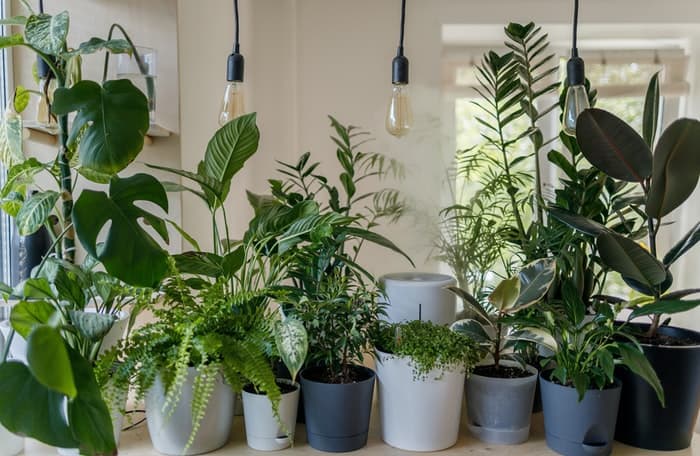Houseplants are beneficial for both the environment and human health. They produce oxygen and absorb carbon dioxide, helping to clean the air we breathe. Houseplants also help to improve indoor air quality by absorbing volatile organic compounds (VOCs) from furniture, carpets, and other household items. Studies have shown that exposure to plants can increase productivity, reduce stress levels, and improve moods.

Do Houseplants Increase Oxygen Levels?
A typical houseplant produces 500 ml of oxygen per day and can improve air quality by up to 20 percent. In order to increase the amount of oxygen in the air, consider placing several plants in different rooms of your house. Not only will you be helping to improve air quality, but you’ll also be adding a splash of color and life to your living spaces.
However, the amount of oxygen produced by a plant varies depending on the type of plant and its size. Smaller plants typically produce less oxygen than larger plants. However, even a small plant can make a big impact on air quality if you have several in your home.
Factors that Affect the Amount of Oxygen the Houseplants Produced
There are many different factors that affect the amount of oxygen a houseplant produces. The size of the plant, the light it receives, and the watering and fertilizing all play a role.
Plants Need Light to Produce Oxygen
Plants need light to produce oxygen because they use light energy to convert carbon dioxide and water into glucose and oxygen. This process, known as photosynthesis, is what allows plants to create their own food and release oxygen into the air. While plants can produce some oxygen in the absence of light, they will produce more if they are exposed to sunlight or artificial light sources.
Size of Plant and Type of Plant
The size of a plant and the type of plant both affect how much oxygen the plant produces. Larger plants produce more oxygen than smaller plants, and plants that produce flowers or fruit also produce more oxygen than plants that do not. Plants that are native to tropical climates typically produce more oxygen than plants that are native to colder climates.
Using UV Light
One of the main factors that affects the amount of oxygen produced by a houseplant is UV light. UV light helps to break down water molecules in the plant’s leaves, which then provides the plant with oxygen. By exposing your houseplant to regular doses of UV light, you can help ensure that it produces more oxygen and stays healthy.
Watering and Fertilizing
Watering and fertilizing plants also affects the amount of oxygen that is produced. For example, when a plant is watered with fertilizer, it produces more oxygen than if it were not fertilized. This is because the fertilizer provides the plant with the nutrients that it needs to grow and produce oxygen. In addition, watering plants regularly helps to produce more oxygen, since the water helps to dissolve the carbon dioxide from the air and release oxygen into the environment.

Which Plants Produce the Most Oxygen?
Houseplants are a great way to improve the air quality in your home. Not only do they add color and life to a room, but they also help to clean the air. In fact, some plants are better at producing oxygen than others.
Here are 10 plants that produce the most oxygen:
Spider Plant
An often overlooked houseplant, spider plants are incredibly easy to care for and produce the most oxygen of any plants. In fact, a single spider plant can provide enough oxygen for a room of up to four people. They’re also great at removing toxins from the air, making them perfect for homes with pets or smokers. Spider plants thrive in bright, indirect light and can be grown either in soil or water.
Areca Palm
The Areca Palm is one of the best plants for improving air quality in your home. They produce more oxygen than any other common houseplant, making them an ideal choice for people with asthma or other respiratory problems. Areca Palms also help to filter out toxins and pollutants from the air, making your home healthier and more comfortable to live in.
Weeping Fig
The weeping fig is one of the most popular houseplants in the world, and for good reason – it produces a lot of oxygen! In fact, a single weeping fig can generate more oxygen than a small potted tree. This makes the weeping fig an ideal plant for improving air quality in your home, office or any other enclosed space.
Weeping figs are also relatively easy to care for. They require medium light levels and regular watering. They are tolerant of a wide range of temperatures, making them a good choice for both warm and cold climates. And if you’re ever away on vacation, you can rest assured knowing that your weeping fig will be just fine without you.
Tulsi
Studies have shown that Tulsi plants produce the most oxygen of any household plant. This is because they are able to convert carbon dioxide into oxygen at a very high rate. Having one or more Tulsi plants in your home can help improve the air quality and increase your overall well-being.
Pothos
There is a good reason why pothos are often recommended as houseplants – they produce the most oxygen! A study found that pothos were one of the plants that produced the most oxygen in low-light environments. This makes them perfect for offices and other indoor spaces where there is limited light.
In addition to producing oxygen, pothos also remove toxins from the air. So not only will you breathe easier with a few pothos plants around, but you’ll also be improving the air quality in your space.
Aloe Vera
Aloe Vera is a succulent plant that is native to Africa. It has been used for centuries to treat a variety of ailments. Aloe Vera is also known for its ability to produce oxygen at night. This makes it an ideal houseplant for people who want to improve the air quality in their homes.
Gerbera Daisy
One of the best plants to increase oxygen levels indoor is the Gerbera Daisy, which produces more oxygen than any other common houseplant. These beautiful flowers come in a variety of colors, making them a perfect addition to any room. They are also easy to care for, making them a great choice for novice gardeners.
Peace Lily
One of the many plants that are great for purifying the air indoors is the peace lily. This plant not only helps to get rid of toxins, but it also produces oxygen. In fact, a peace lily can produce more oxygen than any other houseplant. This is why it’s such a good choice for people who suffer from allergies or asthma.
Snake Plant
The Snake Plant is often considered one of the best plants for increasing oxygen levels in the home. They are easy to care for, and can be kept in a pot or ground planted. Snake Plants produce oxygen during the day and night, making them a good choice for bedrooms.
Conclusion
In conclusion, houseplants produce oxygen and help improve air quality. They are also aesthetically pleasing and can improve your mood. If you are looking for a way to improve the air quality in your home, consider adding some plants to your space.









